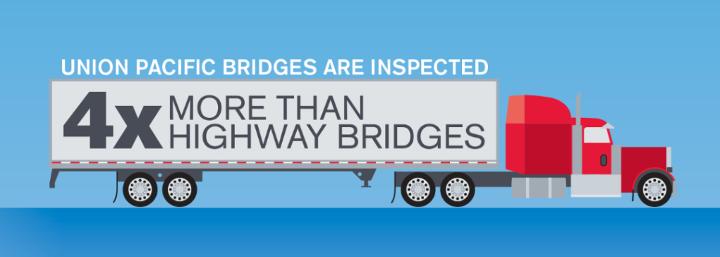About UP's Bridges
Union Pacific's bridges span canyons, estuaries, rivers, roads and other geographic features to help us efficiently deliver America's goods from fruits and vegetables, to smart phones and automobiles.
Bridges are constructed of steel, concrete and timber. The height of our bridges ranges from 20 to 400-plus feet. Our longest bridge, which crosses the East Morganza Spillway in eastern Louisiana, spans more than 18,000 feet.
Many railroad bridges differ from highway bridges in that they were designed and constructed when freight trains were powered by steam locomotives, which were as much as three times heavier than modern freight locomotives. Another major difference is the inspection schedule. UP bridges are inspected four times more than highway bridges.

Detailed Inspection Process
More than 95 percent of UP's bridges are inspected a minimum of twice annually by one of 29 specially-trained two-person bridge inspection teams, exceeding federal requirements. Bridges that are less than 10 years old and have no defects are inspected once annually.
Inspectors carefully examine each bridge component looking for corrosion or cracks in trusses, and decking. These inspections include a detailed "snooper" examination in a truck-mounted articulated basket crane that gives inspectors detailed access above and below the bridge deck.
Bridges along UP's busiest corridors are inspected quarterly. Special inspections are made in the case of severe weather, earthquakes or wildfires.
UP's bridge maintenance professionals perform proactive maintenance and repairs throughout the year. They're led by a group of licensed civil engineers who supervise bridge-related work and processes.

Why are bridges rusty?
Rust is normal and forms on the surface of bridges when steel is exposed to oxygen and water over long periods of time. It's carefully examined and documented by bridge inspectors.
UP employees live and work in more than 7,300 U.S. communities and safety is always the primary focus.